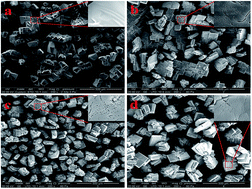Fluorescence Zn-based metal–organic frameworks for the detection of hydrogen sulfide in natural gas
Abstract
Fluorescent zinc-based metal–organic frameworks (Zn-MOFs) were synthesized via the solvothermal method. The materials were characterized by scanning electron microscopy, Brunauer–Emmett–Teller analysis, X-ray diffraction, Fourier transform infrared spectroscopy, fluorescence spectroscopy and fluorescence photography. The results illustrated that the synthesized Zn-MOFs were highly porous with a maximum surface area of 5755 m2 g−1. These MOFs had excellent fluorescence properties, which could be efficiently quenched by trace amounts of hydrogen sulfide (H2S). The experimental results indicated that Zn-MOFs were responsive to H2S at the nmol mL−1 level, which is advantageous for fluorescent Zn-MOF-based sensing materials. The synthesized Zn-MOFs also displayed high adsorption abilities toward H2S. It was illustrated that adsorption played an important role in the preconcentration of H2S, which can further increase the fluorescence quenching efficiency and improve the sensitivity for H2S. Under optimized conditions, this Zn-MOF probe exhibited rapid response, excellent selectivity and sensitivity in detection of H2S. The decrease in FL intensity was linearly related to the H2S concentration between 0.094 μmol mL−1 and 18 μmol mL−1. The developed strategy was applied to real natural gas well samples. These results indicated that Zn-MOF is a usable functional material for H2S detection in natural gas, and potentially useful in monitoring natural gas quality and removing H2S.



 Please wait while we load your content...
Please wait while we load your content...